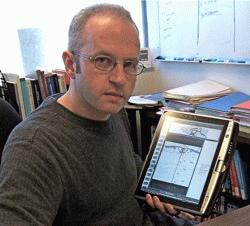ISI Grant Will Ease and Speed Access to Biomed Data

The National Institute of General Medical Sciences has announced a four-year grant to support ISI’s Gully A.P.C. Burns’ efforts to expand and enhance his highly successful NeuroScholar software efforts.
“The new project is very exciting,” says Burns. “Our objective is to provide software that can be used in a laboratory to create a small-scale knowledge base for those scientific articles stored locally in that laboratory as PDF files.”Burns, who was the founder of ISI’s Biomedical Knowledge Engineering Group (BKEG) notes that the knowledge-base for the study of neurobiology (and for biomedical research in general) poses unique access problems.
Typically it consists not just of easily searched and indexed alphanumeric results (though the volume of these is immense), but also detailed images, often three-dimensional.
“We’re trying to alleviate information overload for any biomedical scientist who has to keep track of a complicated subject by reading the literature,” says Burns. “Which is everyone.”
Burns aims at making it possible for a researcher to quickly find out what data exists, and also to make it possible for the researcher to retrieve and query the data from multiple directions. ISI computer scientist and natural language/ knowledge structure expert Eduard Hovy collaborates as BKEG co-PI.
“The project is intended to develop software for use within a laboratory to provide support for researchers at a distributed, medium scale,” he says. “”We will combine knowledge representation and reasoning approaches (in collaboration with the PowerLoom group) with text mining and information extraction methods to assist with the creation of the knowledge base.”

The product will undergo intensive use testing in collaboration by USC neuroendocrinology groups, he says.
Burns current work builds on the recent success of the Neuroscholar project, experimental software that has been downloaded more than 2400 times from sourceforge since its first release in Oct 2005. (see schematic, left)
Downloaders included a physics Nobel laureate — “I was personally very excited when we heard that,” said Burns.
All the software developed will be open-source, and “we hope will integrate well into the larger vision promoted by the Biomedical Information Science and Technology Initiative(BISTI) group at NIH.
“We intend to promote ISI as a major contributor to their powerful vision,” said Burns, pointing to the group’s mission stastatement: “In ten years, BISTI wants every person involved in the biomedical enterprise—basic researcher, clinical researcher, practitioner, student, teacher, policy maker—- to have at their fingertips through their keyboard instant access to all the data sources, analysis tools, modeling tools, visualization tools, and interpretative materials necessary to do their jobs with no inefficiencies in computation or information technology being a rate-limiting step.”
Another Burns project is NeuARt II, a system designed to automatically index and access brain atlas, using the digital information now supplied on CDs the duplicates and supplements printed volumes. In addition to Burns and Hovy, the BKEG group includes programmer Tommy Ingulfsen and grad student Donghui Feng.
Published on March 21st, 2008
Last updated on June 4th, 2024